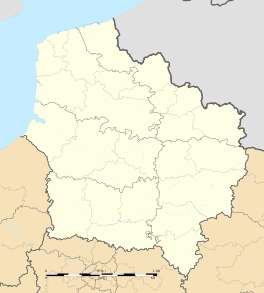Barlin
| Barlin | |
|---|---|
 Barlin | |
|
Location within Hauts-de-France region  Barlin | |
| Coordinates: 50°27′21″N 2°37′10″E / 50.4558°N 2.6194°ECoordinates: 50°27′21″N 2°37′10″E / 50.4558°N 2.6194°E | |
| Country | France |
| Region | Hauts-de-France |
| Department | Pas-de-Calais |
| Arrondissement | Béthune |
| Canton | Barlin |
| Intercommunality | Artois |
| Government | |
| • Mayor (2014–2020) | Gérard Paillard |
| Area1 | 6.18 km2 (2.39 sq mi) |
| Population (2009)2 | 7,549 |
| • Density | 1,200/km2 (3,200/sq mi) |
| Time zone | CET (UTC+1) |
| • Summer (DST) | CEST (UTC+2) |
| INSEE/Postal code | 62083 / 62620 |
| Elevation |
51–131 m (167–430 ft) (avg. 63 m or 207 ft) |
|
1 French Land Register data, which excludes lakes, ponds, glaciers > 1 km² (0.386 sq mi or 247 acres) and river estuaries. 2 Population without double counting: residents of multiple communes (e.g., students and military personnel) only counted once. | |
Barlin is a commune in the Pas-de-Calais department in the Hauts-de-France region in northern France.
Geography
A small ex-coal mining town, now a light engineering and farming commune, situated 7 miles (11.3 km) south of Béthune and 30 miles (48.3 km) southwest of Lille, at the junction of the D57, D179 and the D188 roads.
History
We have to go back to 1141 to find the first mention of the parish of Barlin in a manuscript now kept in the National Archives. It was then spelt Ballin or Bellin. The name changed several times over the centuries: Ballin in 1141, Bellin in 1438 and Barlaing in 1556, it was not until the next century that it became Barlin.
In the 12th century, the territory of Barlin was divided into several lordships which depended on Saint-Pol-sur-Ternoise, Arras or Béthune. In 1207, Thomas Hasbare was seigneur of Barlin. The Melun family succeeded him and one of their lords, nicknamed Le Brun, the king's chamberlain, saw his property confiscated by Duke John the Fearless, who had accused him of alliegence with his enemies. The Duke of Burgundy then donated the land and income of Barlin to Walleran de Juhaucourt.
In the mid-nineteenth century, coalmining began at Barlin and the town flourished. The mines closed in the 1960s.
Today, Barlin is a modern and dynamic place that offers its residents numerous amenities: schools, colleges, a swimming pool, a library and sports halls.
Population
| Historical population | ||
|---|---|---|
| Year | Pop. | ±% |
| 1962 | 8,313 | — |
| 1968 | 8,907 | +7.1% |
| 1975 | 8,007 | −10.1% |
| 1982 | 7,831 | −2.2% |
| 1990 | 7,948 | +1.5% |
| 1999 | 7,925 | −0.3% |
| 2009 | 7,549 | −4.7% |
Sights
- The church of St. Pierre, dating from the eighteenth century.
- The Commonwealth War Graves Commission cemetery.
- The museum
See also
References
External links
| Wikimedia Commons has media related to Barlin. |
- Barlin official website (French)
- Barlin on the Quid website (French)
- Barlin schools' website (French)
- The CWGC communal cemetery extension at Barlin
- Website of the Communauté d'agglomération de l'Artois (French)